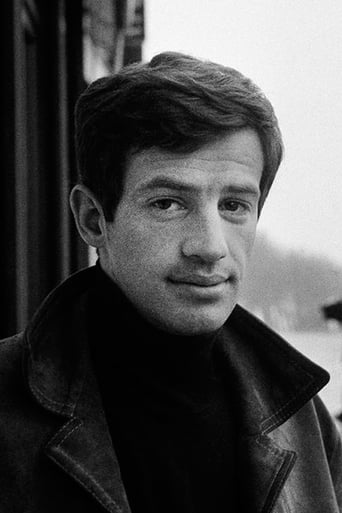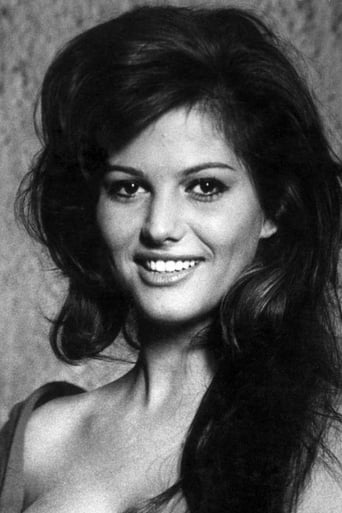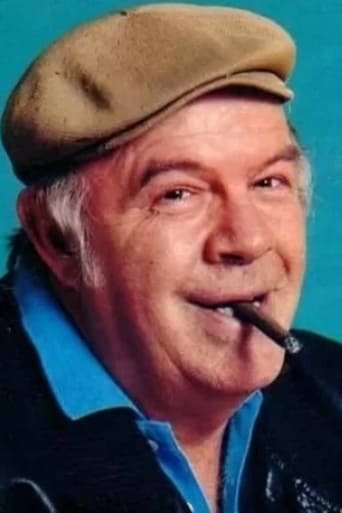ReaderKenka
Let's be realistic.
LouHomey
From my favorite movies..
Contentar
Best movie of this year hands down!
Curt
Watching it is like watching the spectacle of a class clown at their best: you laugh at their jokes, instigate their defiance, and "ooooh" when they get in trouble.
Armand
one of many adventure French films, exploitation of a literary genre and few actors who gives force and charm to a sort of characters. but it is only a first sigh verdict.the story, the fight scenes, Belmondo, Cardinale, Jean Rochefort makes a fine difference in this case. and basic virtue is the vision of director who know transform the plot in axis of seductive show. best part - the end. and science to not present only silhouettes of heroes but realistic figures, mixture of revolt, innocence and humor. a memorable film for old generations but , in same measure, a challenge for present. romance and adventure. and the lights of a splendid French art period.
dlee2012
Cartouche is a 1962 Philippe de Broca offering from France. Ostensibly a well-crafted film, its technical excellence cannot save it from the fact that it represents that most tired and banal of cinematic genres, the swashbuckler.Full of action, there is no depth to this film and Jean-Paul Belmondo's macho posturing throughout would sit more comfortably with an American audience than with a French (or an Australian) one.Indeed, throughout it is clear that the director is trying to create a very Americanised film and it simply does not work in a French context.Whilst the action scenes are themselves well-choreographed, some of the cuts between scenes are very crude.Pacing is a problem that makes this film even more monotonous. The long and unwieldy narrative quickly becomes tiresome as one knows the hero will triumph. Although there is a dark twist towards the end, this is exactly what happens. The character is clearly drawing on the Errol Flynn version of Robin Hood, blended with some elements of Fielding's picaresque hero, Tom Jones.The colour is vivid and the spectacle is on a large scale but one has little sympathy for the characters. Cartouche is so much larger than life, one cannot empathise with him at all, especially given the macho posturing mentioned above. Even the Costner Robin Hood some thirty years later had failings and enough of a back-story to create some empathy. Cartouche, though, has no back-story and there is little character development throughout this film. As he is so uninteresting a character, one quickly loses interest in the film.Despite the problems with the characters, Belmondo and Cardinale as well-cast as the leads and do their best with the thin material.Indeed, Cardinale's character is the most interesting in the film, managing to blend a fiery personality with a submissiveness to Cartouche that would no doubt infuriate feminist audiences today. Indeed, a reading of the film from her character's point of view would make for a fascinating thesis. It is, therefore, her death at the end that gives the film its only real poignancy. Her laying out as a Princess, bedecked with the jewels stolen from the society ladies at the ball is a wonderfully-ironic moment. Likewise, the reflections of the dark, inky water when she is laid to rest give the film its only real moment of cinematic beauty.Besides this, the film's real saving grace is its subversive critique of the military. In the early part of the story, soldiers feature prominently and are consistently shown to be nothing more than state-sanctioned mercenaries. They do not care who they kill, as long as they are well-paid.Along with this ruthlessness, they are shown to be buffoons in uniforms, lacking any kind of depth or redeeming features. This wonderful subversiveness stands well today and gives the film its only depth, particularly when one considers it was filmed during the fallout of the Algerian War.Ultimately, one has mixed feelings about this film. For the most part, it is well-made, with some spectacular action scenes but also some poor editing. The male protagonist is a comic-book character but the female has more depth.The film's saving grace is its subversive quality. It bravely seeks to undermine the military as an organisation full of fools and ruthless, uncaring killers and it also seeks to attack the emerging trend of feminism by showing the loyal, submissive woman as the ideal.Ultimately, though, it is clear that the swashbuckler was a very tired genre by this time and it is fitting that this is one of the last of its type.
dbdumonteil
Louis-Dominique Cartouche (1693-1721) was one of the two famous brigands in France of the XVIII th century the other being Mandrin the smuggler.Cartouche's "career" took place during the Regence (interregnum Louis the XIV th /louis the XV th) whereas his colleague appeared later under Louis the XV th 's reign.He was another Robin Hood ,stealing from the rich and giving to the poor (not only legend).He was a gallant man,seducing many women , collecting the lovers .In the movie ,"Venus" (Cardinale)might represent some of them.His relationship with an aristocratic woman (Odile Versois in the movie) is plausible for he had friends in the nobility .Once he had dinner with one of these high born ladies and he thought her champagne was undrinkable:the day after ,he sent a case of bottles to her.The tragic death of Cartouche is not shown in the movie:like Mandrin ,and like other brigands ,he perished on the wheel ,a terrifying torture .Belmondo who was also De Broca's "L'Homme De Rio" is a dashing handsome chivalrous Cartouche .He gets good support from a stellar cast .The last scene,often praised ,is ,with the "burying at sea" scene of Enrico's "Les Aventuriers" ,one of the most beautiful scenes of the French cinema of the sixties!And,no,they were not Nouvelle Vague ,either De Broca or Enrico !
MARIO GAUCI
I had previously watched this eons ago one Sunday night on Italian TV – a film that has easily come to be universally considered as France's finest offering to the swashbuckling genre and, with this in mind, it more than holds its own alongside Hollywood's best similar offerings. What gives this added texture, then, is the authentic feel for 18th century France (stunningly rendered in widescreen color cinematography by the distinguished Christian Matras, who was particularly adept at this sort of thing), a quality that is undoubtedly further enhanced by a typically wonderful Georges Delerue score; incidentally, listening to it once more, I realized that the lovely romantic theme here was very much a dry run for his celebrated, haunting work on Jean-Luc Godard's CONTEMPT (1963) – which has for some time firmly insinuated itself among my all-time favorite movie scores! Of course, the film finds star Jean-Paul Belmondo at the peak of his powers as the amiable titular rogue; however, his supporting cast – headed by luscious Claudia Cardinale, an atypically villainous Marcel Dalio, as well as Jess Hahn and Jean Rochefort as the hero's rowdy copains – is no less impressive. With respect to the action sequences, the swordfights aren't as plentiful as I had expected, though certainly vigorously handled all the same. As a matter of fact, another element that distinguishes it from contemporary outings in the prolific genre (even where French cinema is concerned), is that there is a good deal more emphasis here on brawling and (especially) romance – with Cartouche (actually a nickname) largely neglecting devoted commoner Cardinale for the amorous attentions of an unattainable aristocratic lady until it's too late. Unusually, therefore, this comes with a downbeat ending in which the heroine sacrifices herself to save her lover from an assailant's arrow – which is then followed by a beautiful and moving funeral rite.For the record, this was the first (and best) of director De Broca and star Belmondo's many collaborations which, box-office-wise, peaked with their next one, THAT MAN FROM RIO (1964), which I also own; incidentally, I have its follow-up UP TO HIS EARS (1965) as well albeit in French without the benefit of English subtitles! I would also love to catch up with the others – LE MAGNIFIQUE (1973) and L'INCORRIGIBLE (1975) – which look to be quite fun from the theatrical trailers I caught some time ago in a French Belmondo Box Set. Furthermore, De Broca would try (and relatively succeed) in recapturing the spirit of CARTOUCHE many years later with a much-filmed swashbuckling property LE BOSSU (1997). By the way, the low-budget Italian production of 1954 which also goes by the name of CARTOUCHE and stars Richard Basehart apparently has nothing else in common with this one (being, for one thing, a much-inferior product). One final thing: although the film under review is also available as a Special Edition DVD in France, I opted for the cheaper, barebones R1 disc from Anchor Bay given the prohibitively expensive shipping charges and the typical unavailability of English subtitles on the included audio commentary!





